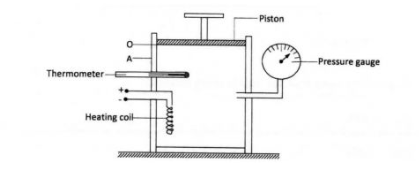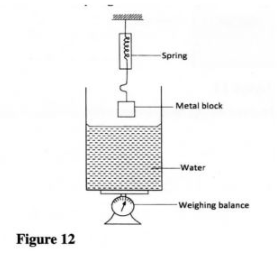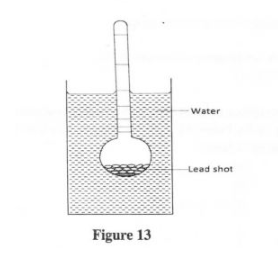
.1 Physics Paper 1 (232/1)
SECTION A (25 marks)
Answer all the questions in this section in the spaces provided.
1 Figure 1 shows part of the main scale and vernier scale of a vernier callipers.

Figure 1
Record the reading indicated. (1 mark)
2 State one factor that affects the turning effect of a force on a body. (1 mark)
3 Figure 2 shows some air trapped by mercury in a glass tube. The tube is inverted in a dish containing mercury.

Figure 2
Given that the atmospheric pressure is 760 mmHg and the height of mercury column in the tube is 600 mm, determine the pressure of the air trapped in the tube in mmHg. (3 marks)
4 An object of weight 20 N attached at the end of a spring causes an extension of 0.5 cm on the spring.
(a) Determine the spring constant of the spring. (2 marks)
(b) Determine the weight of an object that would cause an extension of 0.86 cm when attached at the end of the same spring. (1 mark)
5 State two measurements you would take in an experiment to determine the upthrust of an object which is immersed in a fluid. (2 marks)
6 State how the measurements in question (5) are used to determine the upthrust of the object. (1 mark)
7 Figure 3 shows a piece of wood fitted into a copper pipe and a piece of paper wrapped tightly around the junction.

Figure 3
It is observed that when a flame is applied around the paper at the junction, the side of the paper around the wood burns first. Explain this observation. (2 marks)
8 Figure 4 shows a uniform metre rule of weight I N with two weights of 0.18 N and 0.12 N suspended from its ends.

Figure 4
Determine how far from the 0.18 N weight a pivot should be placed in order to balance the meter rule. (3 marks)
9 Explain why brakes fail in a hydraulic braking system when air gets into the system.
10 Figure 5 shows a Bunsen burner.

Figure 5
Explain how air is drawn into the burner when the gas tap is open. (3 marks)
11 Figure 6 (a) and 6(b) show capillary tubes inserted in water and mercury respectively.

It is observed that in water the meniscus in the capillary tube is higher than the meniscus in the beaker, while in mercury the meniscus in the capillary tube is lower than the meniscus in the beaker. Explain these observations. (2 marks)
12 State why it is necessary to leave an air space in a closed glass bottle of water when it is to be kept in a refrigerator. (1 mark)
13 A drop of blue ink is introduced at the bottom of a beaker containing water. It is observed that after some time, all the water in the beaker turns blue. Name the process that takes place. (1 mark)
SECTION B (55 marks)
Answer all the questions in this section in the spaces provided.
14 (a) State two ways in which the centripetal force on a body of mass m can be increased (2 marks)
(b) Figure 7 shows an object at the end of a light spring balance connected to a peg using a string. The object is moving in a circular path on a smooth horizontal table with a constant speed.

Figure 7
(i) State what provides the centripetal force. (1 mark)
(ii) Indicate with an arrow on the figure the direction of the centripetal force. (1 mark)
(iii) State a reason why the object is accelerating while its speed remains constant. (1 mark)
(iv) Given that the mass of the object is 0.5 kg and it is moving at a speed of 8 ms-1 at a radius of 2 m, determine the reading on the spring balance. (3 marks)
(c) A stone thrown vertically upwards reaches a height of 100 m. Determine the: (i) initial velocity of the stone. (2 marks)
(Neglect air resistance and take g = 10 ms-2)
(ii) total time the stone is in air. (2 marks)
15 (a) State the meaning of the term “specific latent heat of fusion”. (1 mark)
(b) Figure 8 shows a set up of apparatus used in an experiment to determine the specific latent heat of fusion of ice.

Figure 8
The following readings were noted after the heater was switched on for 5 minutes:
– mass of beaker = 130 g
– mass of beaker + melted ice = 190 g
(i) Determine the:
(I) energy supplied by the 60 W heater in the 5 minutes. (3 marks)
(II) specific latent heat of fusion of ice. (4 marks)
(ii) It was observed that some of the crushed ice melted even before the heater was switched on. State a reason for this observation. (1 mark)
16 (a) A horizontal force of 12 N is applied on a wooden block of mass 2 kg placed on a horizontal surface. It causes the block to accelerate at 5 ms-2. Determine the frictional force between the block and the surface. (3 marks)
(b) Figure 9 shows a graph of velocity against time for a ball bearing released at the surface of viscous liquid.

Figure 9
Explain the motion of the ball bearing for parts
(i) OA (2 marks)
(ii) AB (2 marks)
(c) Figure 10 shows a pulley system used to raise a load by applying an effort of 500 N.
Figure 10

State the:
(i) velocity ratio of the system. (1 mark)
(ii) purpose of pulley 2. (1 mark)
(iii) Given that the machine has an efficiency of 80%, determine the maximum load that can be raised. (3 marks)
17 Figure 11 shows an insulated cylinder fitted with a pressure gauge, a heating coil and a frictionless piston of cross-sectional area 100 cm2.

Figure 11
(a) While the piston is at position O, the pressure of the enclosed gas is 10 Ncm-2 at a temperature of 27°C. When a 10 kg mass is placed on the piston, it comes to rest at position A without change in the temperature of the gas.
(i) Determine the new reading on the pressure gauge. (4 marks)
(ii) State with a reason how the value obtained in (i) compares with the initial pressure. (2 marks)
(b) The gas is now heated by the heating coil so that the piston moves back to the original position O.
(i) State the reading on the pressure gauge. (1 mark)
(ii) Determine the temperature of the gas in °C. (4 marks)
(Take g = 10 Nkg-1).
18 (a) Figure 12 shows a weighing balance on which a beaker containing some water is placed. The reading on the balance is 2.80 N. A metal block weighing 2.7 N is suspended from a spring balance.

Figure 12
(i) State what is observed on the spring balance and the weighing balance, as the metal block is gradually lowered into the water.
(I) Observation on spring balance. (1 mark)
(II) Observation on weighing balance. (1 mark)
(ii) Explain the observation made on the spring balance in (I). (2 marks)
(iii) When the metal block is fully immersed in the water, the reading on the spring balance is found to be 2.46 N. Determine the:
(I) reading on the weighing balance. (2 marks)
(II) density of the metal. (3 marks)
(c) Figure 13 shows a hydrometer with a thin stem floating in water in a beaker.

Figure 13
State with a reason what is observed on the hydrometer when the temperature of the water is raised. (2 marks)
